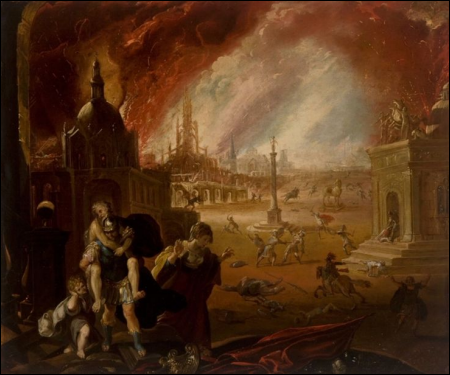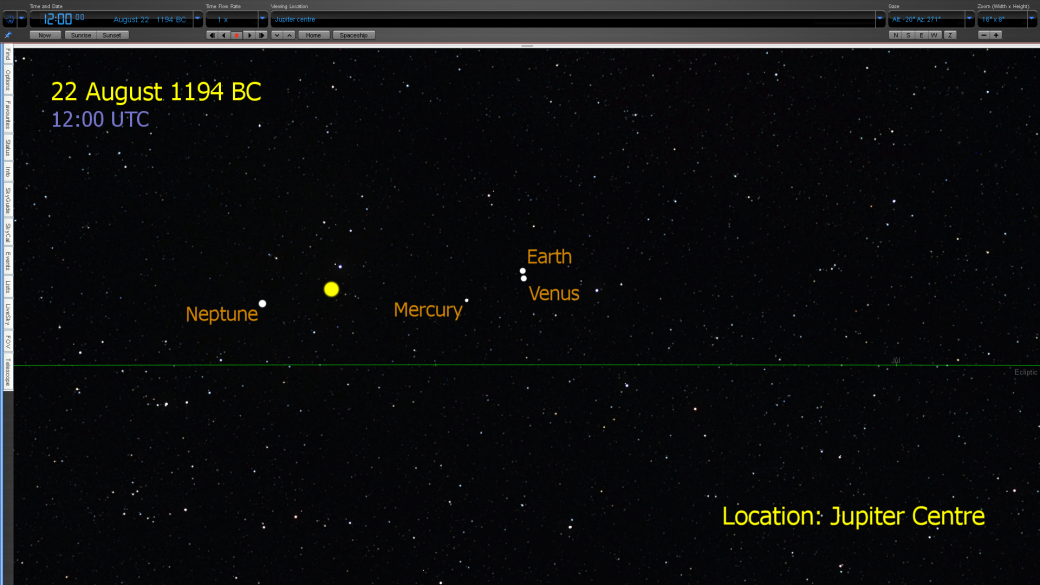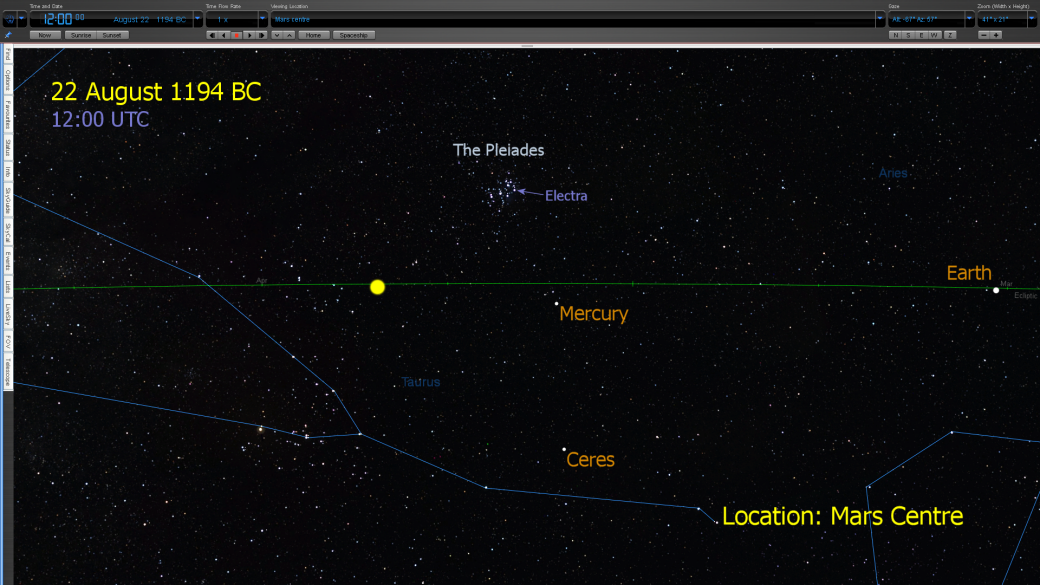The Bronze Age Collapse: 1194 BC
The Late Bronze Age, spanning roughly 1600 to 1200 BC, was a period of remarkable interconnectedness and cultural flourishing across the Eastern Mediterranean and Near East. Powerful empires such as the Hittites, Egyptians, Assyrians and Mycenaeans thrived, engaging in extensive trade, diplomacy, and warfare.
Around 1200 BC however, this vibrant world experienced a sudden and dramatic collapse, often referred to as the Bronze Age Collapse. This event marked the end of several major civilizations, leading to a period of decline, depopulation, and cultural regression known as the Late Bronze Age Dark Age. The causes, extent, and timing of this collapse have been the subject of intense scholarly debate, with evidence drawn from archaeology, geology, and ancient texts.

The Nature of the Collapse
The Bronze Age Collapse was a regional phenomenon, primarily affecting the Eastern Mediterranean and Near East, including modern-day Greece, Turkey, Syria, Lebanon, Israel, and Egypt. It was not a global event, but rather a series of interconnected crises that destabilized the region. Major urban centres were abandoned or destroyed, trade networks disintegrated, and literacy declined significantly. The Hittite Empire, a dominant power in Anatolia, vanished entirely. Mycenaean Greece experienced the destruction of its palaces and a sharp decline in population. In Egypt, the New Kingdom faced invasions and internal strife, leading to its eventual decline. The extent of the collapse is evident in the archaeological record, which shows widespread destruction layers at sites such as Ugarit, Troy, and Mycenae.
Geological and Environmental Evidence
One of the key factors contributing to the Bronze Age Collapse was environmental change. Geological evidence suggests that the period around 1200 BC was marked by severe droughts and climatic instability. Studies of sediment cores from the Dead Sea and the Mediterranean have revealed evidence of prolonged arid conditions, which would have strained agricultural production and water resources.
A 2013 study for example by Kaniewski et al., published in PLOS ONE, analysed pollen samples from Syria and found a significant decline in arboreal pollen, indicating deforestation and aridification during this period. An environmental stress that likely exacerbated social and economic tensions, contributing to the collapse.
Archaeological evidence also points to the role of natural disasters. Some scholars have proposed that earthquakes played a significant role in the destruction of cities. For instance, the site of Troy shows signs of seismic activity, and the Mycenaean palaces in Greece were destroyed by fire, possibly triggered by earthquakes. That being said, although natural disasters may have contributed to the collapse, they alone cannot explain the widespread and simultaneous decline of multiple civilizations.
Ancient Records and the Sea People Invasion

Ancient texts provide valuable insights into the turmoil of the Late Bronze Age. Egyptian records, particularly the inscriptions of Pharaoh Ramses III, describe invasions by a mysterious coalition known as the "Sea Peoples." These groups, whose origins remain unclear, are depicted as raiders who attacked coastal cities and disrupted trade routes. Ramses III claimed to have defeated the Sea Peoples in a series of battles, but the invasions likely contributed to the destabilization of the region. The Egyptian records, while propagandistic, align with archaeological evidence of destruction at sites such as Ugarit, where letters pleading for assistance against invaders have been found.
The Hittite archives also provide clues about the collapse. Texts from Hattusa, the Hittite capital, reveal internal strife, food shortages, and threats from external enemies. However, the Hittite records abruptly end around 1200 BC, coinciding with the destruction of their capital and the disappearance of their empire.
Dating the Bronze Age Collapse
Pinpointing the exact date of the Bronze Age Collapse has proved a challenge due to the limitations of ancient chronology. That said, the most widely accepted timeframe is around 1200 BC, based on a combination of archaeological and textual evidence. The destruction layers at key sites, such as Ugarit and Mycenae, are dated to this period using pottery typology and radiocarbon dating. For example, a study by Manning et al. (2016) in Nature used radiocarbon dating to refine the chronology of the Late Bronze Age, confirming that the collapse occurred in the late 13th to early 12th century BC.
Going further still, in terms of isolating the collapse as precisely as possible, respecting its sudden onset, perhaps the most important journal article upon the topic appeared in PLOS ONE, 8 June 2011, entitled: The Sea Peoples, from Cuneiform Tablets to Carbon Dating (once again by David Kaniewski et al). According to the abstract (emphasis added) [1]:
“Here, we report a stratified radiocarbon-based archaeology with anchor points in ancient epigraphic-literary sources, Hittite-Levantine-Egyptian kings and astronomical observations to precisely date the Sea People event. By confronting historical and science-based archaeology, we establish an absolute age range of 1192–1190 BC for terminal destructions and cultural collapse in the northern Levant.”
In addition to this, Egyptian records provide further chronological markers. The inscriptions of Ramses III dated to around 1177 BC describe how the invasion of the Sea Peoples directly contributed to the decline of Egyptian power. A date often cited as the symbolic endpoint of the Bronze Age Collapse, marking the last major effort by a Bronze Age empire to repel an external threat.

Upheaval with the Celestial Realm
Although the Bronze Age Collapse appears to have had an environmental component, there is at least one thinker who believed that it also had a celestial component: Edward Gibbon, author of the great work: The History of the Decline and Fall of the Roman Empire. In the course of detailing the downfall of the Roman Empire, Gibbon found himself venturing into a discussion on comets, and their association with earthbound upheaval. In this regard, there is one particular reference made in Gibbon’s book highly pertinent to this current discourse. That in the year 1193 BC, a great comet appeared in the skies. One that would appear to be encoded in Greek mythology.
The relevant passage from his book is as follows:
“…the year eleven hundred and ninety-three, is darkly implied in the fable of Electra the seventh of the Pleiads, who have been reduced to six since the time of the Trojan war. That nymph, the wife of Dardanus, was unable to support the ruin of her country: she abandoned the dances of her sister orbs, fled from the zodiac to the north pole, and obtained, from her dishevelled locks, the name of the comet.”
Now it is important to realise that the 1193 BC date mentioned by Gibbon, is not a precise citation from some ancient source, but derived via a clever extrapolation, the details of which are covered more fully in his book. Suffice it to say, there is a certain margin of error with his date, but the fact that it is so close to the estimates previously given for the Bronze Age collapse (1192-1190 BC) is highly suggestive. Indeed, it would appear to be decisive, given a slight adjustment.
1194 BC – A Destructive Conjunction Pattern
Gibbon would seem to have been wrong by just one year. The correct date of the mysterious comet sighting being 1194 BC. More specifically, 22 August 1194 BC. A top down view of the solar system upon this date reveals the following:

From a close study of the diagram, two separate alignments can be seen occurring simultaneously. One involving Ceres, Mercury and Mars. The other involving Jupiter, the Earth and Venus. (NB; For an important note on modelling the orbit of Ceres, see note [2] in the Notes section at the bottom of this article).
It is the contention of this present researcher, that this configuration was directly responsible for the Bronze Age collapse. What triggered all kinds of celestial effects and earthbound upheaval, all of which devastated the civilisations of the Earth at the time.
Consider the accuracy of each alignment in turn, firstly from the perspective of the planet Jupiter:

Here one can see exceptional accuracy in the triple alignment involving Jupiter, the Earth and Venus – at optimum upon the noted date.
Likewise, from the perspective of Mars, one can see extreme accuracy in the triple conjunction involving Ceres and Mercury. This by far being the most significant of the two; revealing the underlying mythological considerations outlined by Gibbon i.e. the link to The Pleiades and one of its key stars: Electra:

With respect to the Mars-Mercury-Ceres alignment, the dwarf planet Ceres is the most crucial planet to note. This being the most prominent celestial body within the asteroid belt, located between Mars and Jupiter.
Now what is so notable about this planet, is its propensity for occasionally ‘flaring up’ to develop cometary properties i.e. a cometary tail. To be sure, when caught up in the 1194 BC alignment, as detailed, this present researcher contends that it did just that. The effect no doubt heightened due to the triple alignment also involving The Pleiades star group. One of the most dangerous directions in the sky, as confirmed elsewhere.
A Lunar Eclipse Contribution
In addition to the two planetary alignments, there is also something else to consider. After achieving their optimum (on 22 August 1194 BC), a total lunar eclipse occurs just one day later, seen at its optimum in the following screenshot:

As with The Exodus alignment, once more an eclipse closely coincides with the optimal (destructive) planetary configuration. And again, with a Pleiades connection. In this instance though, with a mythological story accompanying it, as related by Gibbon.
Foreknowledge of the Bronze Age collapse
If the Bronze Age collapse was the result of a destructive planetary alignment, then as with Noah’s Flood and The Exodus, one might wonder if there is an elegant calendar solution suggestive of foreknowledge. It would seem so. And here one may consider a simple multiple of a special calendar adjustment value previously shown to have been employed to target the 1970 BC alignment (as detailed in an earlier article): 96 days.
To summarise in brief, one may recall the Great Conjunction pattern of 3153 BC, involving Mars, Venus, the Sun and Mercury aligned to the Galactic centre, with the Sun and the Earth simultaneously in close alignment with The Pleiades. The precise date of the alignment was 2 October 3153 BC (Julian Day number: 570065).
From this, the next instance of the same configuration occurred on 8 October 1970 BC; the total number of days separating both alignments being exactly 432096 days:
2 October 3153 BC + 432096 = 8 October 1970 BC
Here then, the very first 96 days were an initial adjustment, counted just prior to the Long Count (of the Mayans) commencing, as would target the next instance of the alignment. In this case, the aim was to synchronise three Baktun units to the 1970 BC date (1 Baktun = 144000 days, with 3 Baktuns = 432000 days). Of course a basic 360-day calendar cycle could also have been used instead to achieve the same end; counting exactly 1200 such cycles (as 360 × 1200 = 432000 days).
Bearing this in mind then, consider the optimum method i.e. the most elegant and concise way to countdown to the Bronze Age Collapse, starting out from The Exodus alignment date.
The best way to proceed would appear to involve an initial adjustment value that is a precise multiple of 96 days, combined with the previously noted 819-day calendar cycle – the very same unit of time used to target Noah’s Flood (from 3153 BC to 2348 BC). In this regard, consider the following:
The Exodus alignment date = 28 March 1457 BC
96 × 4 = 384 days
28 March 1457 BC + 384 days = 16 April 1456 BC
After which, one begins to count cycles of 819 days. Unlike with the Noah Flood count however, which used 359 cycles, here one counts precisely 117 such cycles:
117 × 819 days = 95823 days
16 April 1456 BC + 95823 = 22 August 1194 BC: Bronze Age collapse Alignment
Further Numerological-Mythological Connections
Overall, the above provides a very elegant solution. That being said, it is not the only mathematical solution which targets the proposed Bronze Age Collapse date in 1194 BC. There are other connections – one of which arguably falls under the category of ‘utterly decisive,’ respecting a very well-known Greek mythological story.
The connection in question however is related to a future destructive alignment, specifically occurring in 687 BC. This is covered in-depth in another article in this series (The Story of Phaethon). To fully appreciate the correct date of the Bronze Age collapse disaster – specifically triggered by a set of planetary alignments, one will need to consult this additional essay. Before arriving there however, there is another ‘day of disaster’ to consider, very close to the midpoint of the eighth century BC. This being the next article in this series:
Next: Mid-8th Century BC Upheaval
Back to: Signs of the Times Menu
Notes
[1] https://journals.plos.org/plosone/article?id=10.1371/journal.pone.0020232
[2] Concerning modelling the dwarf planet Ceres, I use Starry Night Pro 6.0 softwareSee this article for more information: Ceres Orbital Solution Considerations